 Newbies on the Farm: a Bug, a Truck and a Cow!
Newbies on the Farm: a Bug, a Truck and a Cow!
Let’s start with the “bad bug” news. The prolonged heat wave we experienced last week may have extended the harvest of dry-farmed tomatoes, green beans and peppers for a few more weeks but on the flipside it also attracted a new exotic heat loving insect pest, a stink bug called Bagrada.
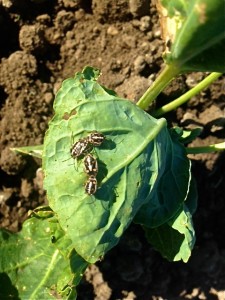 This African native has already spread to many parts of the world, and was first spotted in Southern California in 2008. With a preferential and voracious appetite for plants belonging to the mustard family (broccoli, cauliflower, cabbage, brussel sprouts, chinese cabbage, arugula, bok choi, etc.) it has recently arrived in the Central Coast. Warm, dry weather provides the perfect conditions for it to quickly multiply and spread. Last week’s heat wave must have been the best opportunity for the Bagradas to pay us their first visit. We first spotted them on a broccoli plant in the Discovery Program garden, and yesterday we could also see them munching on our second and still young planting of brussel sprouts. Half of the field was already affected. Without natural enemies and no effective organic control methods yet identified, we are facing a challenging situation. Many farmers in warmer inland areas have reported serious damage, especially to young plants. Only colder and wetter weather, something we are all praying for this winter, is our best hope to slow down the Bagrada invasion.
This African native has already spread to many parts of the world, and was first spotted in Southern California in 2008. With a preferential and voracious appetite for plants belonging to the mustard family (broccoli, cauliflower, cabbage, brussel sprouts, chinese cabbage, arugula, bok choi, etc.) it has recently arrived in the Central Coast. Warm, dry weather provides the perfect conditions for it to quickly multiply and spread. Last week’s heat wave must have been the best opportunity for the Bagradas to pay us their first visit. We first spotted them on a broccoli plant in the Discovery Program garden, and yesterday we could also see them munching on our second and still young planting of brussel sprouts. Half of the field was already affected. Without natural enemies and no effective organic control methods yet identified, we are facing a challenging situation. Many farmers in warmer inland areas have reported serious damage, especially to young plants. Only colder and wetter weather, something we are all praying for this winter, is our best hope to slow down the Bagrada invasion.
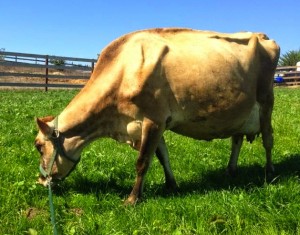 On a more positive note, last week we welcomed the arrival of Bella, our first Milking Cow. Bella is owned by a group of members, and lives in the pastures together with our ponies. I milk her twice a day, and she has been giving an abundance of delicious creamy milk. My wife Constance is right when she questions my sanity of adding another project to an already filled-out life. I always dreamt of having a milking cow, and now that I have reached middle age I don’t believe in driving a sports car or acting any younger than I should, so why not let unfulfilled dreams come true. Writing my part of the newsletter might be bit compromised, though. I like to write early in the morning, the same time Bella needs to be milked. I hope you all understand!!
On a more positive note, last week we welcomed the arrival of Bella, our first Milking Cow. Bella is owned by a group of members, and lives in the pastures together with our ponies. I milk her twice a day, and she has been giving an abundance of delicious creamy milk. My wife Constance is right when she questions my sanity of adding another project to an already filled-out life. I always dreamt of having a milking cow, and now that I have reached middle age I don’t believe in driving a sports car or acting any younger than I should, so why not let unfulfilled dreams come true. Writing my part of the newsletter might be bit compromised, though. I like to write early in the morning, the same time Bella needs to be milked. I hope you all understand!!
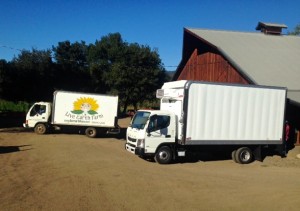 Talking of dreams – here is another that came true last week. The farm at long last has its own refrigerated delivery truck. It couldn’t have come at a better time. With farm deliveries happening almost every single day of the week, many going all the way to San Francisco, we now have both more flexibility in our schedules and, most importantly, our produce quality is less compromised. This truck, a 2015 Mitsubishi, is brand new. It gives us better gas mileage, has no harmful emissions (water vapor and Nitrogen), and replaces our older trucks which will retire to serve more local and on-farm hauling needs.
Talking of dreams – here is another that came true last week. The farm at long last has its own refrigerated delivery truck. It couldn’t have come at a better time. With farm deliveries happening almost every single day of the week, many going all the way to San Francisco, we now have both more flexibility in our schedules and, most importantly, our produce quality is less compromised. This truck, a 2015 Mitsubishi, is brand new. It gives us better gas mileage, has no harmful emissions (water vapor and Nitrogen), and replaces our older trucks which will retire to serve more local and on-farm hauling needs.

The new truck’s refrigerator unit can be run separately, allowing the shares to be stored in it overnight so there is more room in our cooler and the delivery team (Luis on the right, Victor on the left) can get on the road earlier since the truck doesn’t need to be loaded in the morning.
On my field walks I never tire of digging, tasting, smelling, touching, and observing the constant changes taking place on the farm, whether it’s in the fields, orchards, or non-cultivated wild spaces.
Right now, as we approach the Summer Solstice, the farm is a continuously changing canvas of activity and fertile growth. I try to walk the land we farm every day, otherwise it’s easy to miss things. In the coming days, if temperatures do climb into the 90’s as predicted, several crops will need to be watched carefully since they will ripen and mature much faster. Green beans, still tiny right now, can double in size within a day, or some of the apricots, already turning orange in color but still hard to the touch, will most likely be ready to harvest.

Almost, but not quite, ripe.
Daily field walks also help me identify and ward off damaging diseases or insects early on. Especially with flea or cucumber beetles, I like to cover young seedlings with row covers or make timely applications of kaolin clay to minimize their damage.

Row covers protect vulnerable seedlings from pests.
On my walks I always check the soil moisture in the fields. The easiest and quickest way is to use my hands, digging into the top 4-5 inches of soil and feeling the moisture by kneading and sifting the soil through my fingers. At the same time, while I check the moisture level, I determine whether a crop needs cultivating. Cultivating the soil is not only critical in aerating the soil to increase water and nutrient uptake, but also to remove competing weeds.

Digging in the dirt to test soil moisture and friability.

Weeding rows of recently transplanted seedlings.
During Saturday’s community farm day, I spotted a few limp and wilted looking potato plants while digging for these underground treasures with the kids. I have seen this often enough to know that a gopher was at work. The “rascal”, I noticed, had advanced at least 10 feet down a bed of red potatoes. Typically I would take note to trap him, but since we are planning to harvest that block this week anyway he will continue to enjoy a few more days of indulgence.

The potato harvest has begun.
The joy of walking the fields is that there are always new or unexpected things to discover, whether it’s the tiny clusters of grapes hanging off the vines starting to swell in size, watching the red-tail hawks circling above the fields or simply enjoying the flavors of a fully ripened yellow raspberry.

Clusters of young Concord grapes.
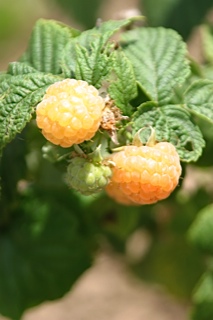
The first golden raspberries.

 Foraging and U-Picking the Abundance of Summer
Foraging and U-Picking the Abundance of Summer
Summer foraging is one of the great pleasures here on the farm, and with the abundance of harvest-able crops right now it doesn’t take much of a field walk to fill a bushel basket and one’s tummy all at the same time. A typical walk for me starts in the apple orchards. August is a special time when the trees hang heavy with fully sized apples maturing and showing their true colors as they ripen.
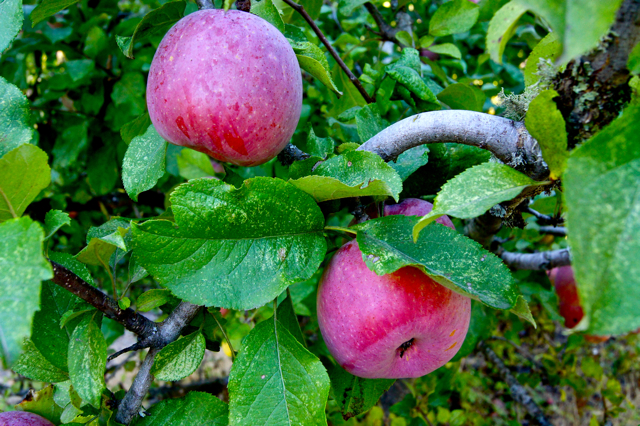
Fuji Apples
In order to anticipate when it’s time to start picking, I do a lot of sampling from different locations on both the individual trees and around the orchard. This year it’s especially tricky since the spring bloom spanned over a much longer period, resulting in uneven maturity and ripeness. I pay close attention to the early varieties that usually ripen sometime this month, choosing apples with good color to test for sugar content while at the same time evaluating their texture and flavor. The best judge is my daughter, who loves apples and is not shy to tell me which she likes best. The Sommerfelds and Pink Pearls are the ripest, with the highest sugar content. They’ll be ready to start picking by the end of the week. The Galas and McIntosh are not far behind – probably 7-10 days out.

Gala Apples
Heading back to the barn with half-munched-on apples in my arms, I can’t resist making a detour to snack on a row of ripe, still unpicked red raspberries. Lucky me, I spot an empty crate on the side of one field which lets me free up my hands to load up on peppers, tomatoes, cucumbers and of course my favorite Sungold cherry tomatoes. I am set for lunch!
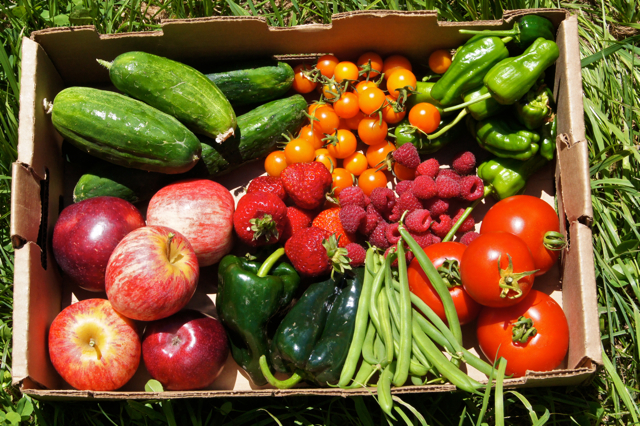
The perfect summer lunch on the farm.
It’s a team effort and dynamic dance right now to keep up with the workload. With such abundance in the fields, we all know, now’s the time when we have to maximize our return. We check on crops daily, sometimes even more often, to assess both quality and quantity to project and spread the harvest for our weekly commitments to CSA members, customers at farmer’s markets, and wholesale and retail accounts. Days are long to keep up with all the harvesting, packing, loading, and delivering. Fieldwork can’t fall behind as we are already preparing for fall and winter. Timing is everything, and little delays and breakdowns can be stressful when dealing with an already full plate.
The best way to experience the farm’s bounty at this point in the season is to come and visit the farm. This Saturday, August 16th, from 10-3 join us for our first Dry-farmed Tomato U-Pick of the Season. If you can’t make it this Saturday, we will have a 2nd U-Pick on August 30th to benefit the farm’s Discovery Program. At this time of year we won’t limit the U-Pick to just dry-farmed tomatoes, but encourage you to also explore other parts of the farm where you can pick favorite crops such as Raspberries, Blackberries, and Cherry Tomatoes. HOPE YOU CAN MAKE IT – SEE YOU ALL ON THE FARM.
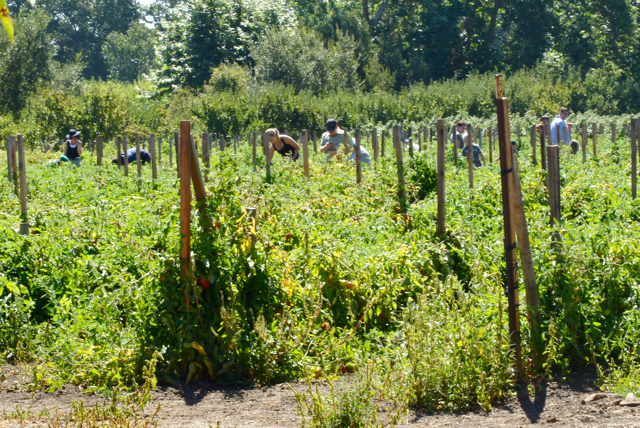
 The Joy of Community Farm Days
The Joy of Community Farm Days
The French called tomatoes “pomme d’amour” or Love Apples, and I agree, what is there not to love about tomatoes – this year’s crop of dry-farmed tomatoes with it’s “alluring” deep red colors are bursting with “seductive” rich flavors.

Saturday’s Tomato U-Pick was testimony to how much we love tomatoes. The image that brings a smile to my heart is of a baby girl accompanying her dad, who is carrying two large bags of freshly harvested tomatoes, while she is munching on a large red tomato with juice dripping down her chin and shirt. “This is the first tomato she ever tasted” her dad commented.
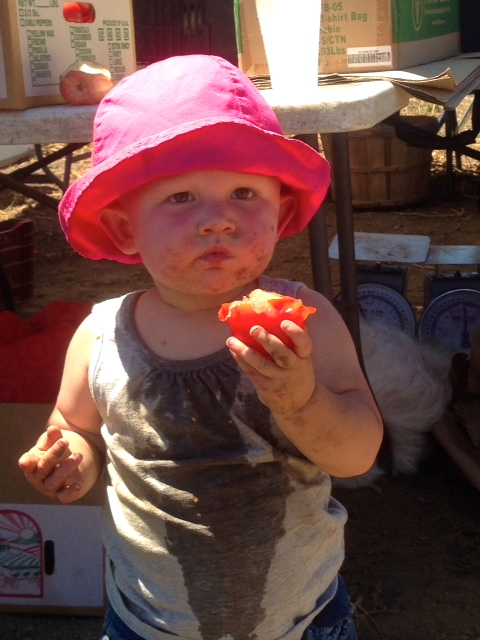
As a farmer this may be the most rewarding moment – to experience the joy and pleasure at the completion of a crop’s lifecycle, tended from seed to maturity.
When children come to the farm they can engage their senses to discover the pleasures of real food. With Live Earth Farm’s Discovery Program, we have expanded our ability to reach out to children and youth in this county by stewardship. Last year in addition to our monthly community farm days and seasonal celebrations, over 1500 children and young adults came to the farm, attending farm tours, workshops, summer-camps, and curriculum based work-leadership programs.
“Love Apples galore, come and get some more!”
Join us for another Community Farm Day on August 30th from 10:00 AM – 3:00 PM.
This will be a great day to enjoy the farm and directly support our educational efforts, as 20% of the proceeds will benefit the Live Earth Farm Discovery Program.
With apples reaching their peak of ripeness, we will open the U-Pick to our Royal Gala Orchard as well as the Dry-farmed Tomato field. The day will include tractor rides, farm tours, apple cider pressing, and child friendly farm games and activities. Invite friends and family; help us spread the word as we invite everyone to enjoy a nourishing, fun and bountiful summer day on the farm.
Click here for more pics from last Saturday’s Community Farm Day & U-pick
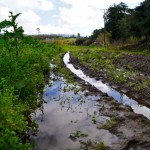 Winter Reflections
Winter Reflections
After a few weeks of relative quiet here on the farm we are excited to resume our weekly delivery of winter shares. My own rhythm has slowed considerably and mimics that of the farm. Plants move nutrients more slowly during winter, which results in often sweeter and more pronounced flavors. Carrots become crisper, and when temperatures dip into the 30’s brassicas, like kale, Brussels sprouts, broccoli, cauliflower and collard greens respond by converting starches into sugars, increasing their brix concentration (brix is a measure of solids and sugars in the plant’s sap). A higher brix level protects plants from freeze damage and sweetens their taste.

Pictured here is a field we are currently harvesting from – chard in front, red russian kale in the middle, and lacinato (dino) kale in the back.
While the earth is in its seasonal slumber I give myself permission to dream, reflect, meet people I normally don’t get to see during the growing season, and of course get a little more sleep. I ponder what the dance will be like for the upcoming main growing season. For sure we’ll have uncertainties and challenges to face, whether it’s unpredictable rainfall and temperature patterns, exotic insect pests like the new brassica loving Bagrada stinkbug, or an increasingly tenuous groundwater supply. While the world around us is filled with complexities and contradictions, farming is very grounding. The reality of farming with its ceaseless dynamic of change and uncertainty requires steadfast perseverance offering both hope and caution at the same time.
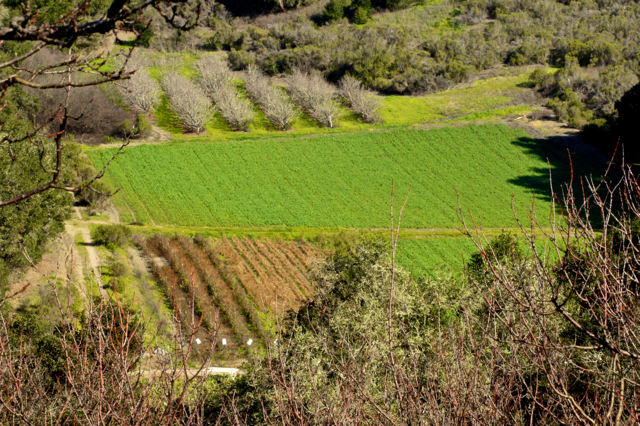
Winter is a time of cover crops and leafless (apple) trees.
Looking at the seed catalogs as we craft this year’s crop plan the farm is a beautiful canvas of possibilities, and that familiar eagerness to jump on new projects stirs inside of me. Soon the buds on the trees will start swelling, I already see the first flower buds forming on the strawberries, and the green house is starting to become active again. The dry weather allowed us to get some field planting done, and this week we started pruning the apple trees. Before we know it’ll be spring and we’ll surrender once again to another seasonal call to tend to Mother Nature’s rewarding abundance.
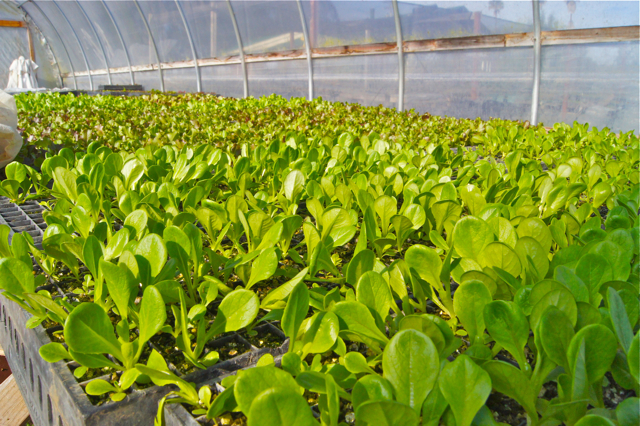
Lettuce seedlings almost ready for transplanting.
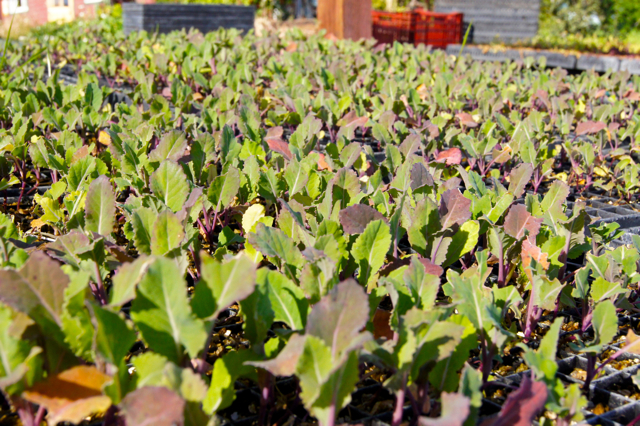
These red russian kale seedlings are being “hardened off” outside the green house before they get planted in their field.
 What’s on your plate can make a difference
What’s on your plate can make a difference
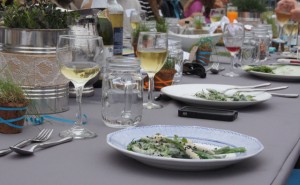 On Earth Day like on any other day most of us eat 1-3 meals. Eating a meal, this humble ritual, affects not only our own physical health and well-being but collectively, as a human community, it is arguably the most important activity affecting the health of our planet.
On Earth Day like on any other day most of us eat 1-3 meals. Eating a meal, this humble ritual, affects not only our own physical health and well-being but collectively, as a human community, it is arguably the most important activity affecting the health of our planet.
Most of us “Eaters” are so removed from the actual practice of growing and raising food that for the majority, food is nothing but a commodity– expecting it to be there when we want it, continuously produced on some unknown farm, by unknown farming practices, performed by unknown people.
Food for the most part is an abstract idea until we physically take it off the shelf or see it on a plate in front of us. This state of alienation has welcomed an industrialized food-system, focused on producing large quantities of food for the highest profit. It in turn has lowered the quality of the food we eat, diminished our quality of life, and degraded much of the natural environment that sustains us.
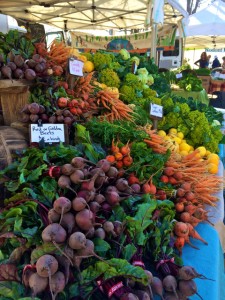 What nourishes our passion for farming is to share the results of our efforts as we pack them into CSA shares, offer them at the farmer’s markets or provide them to local stores and restaurants for people to enjoy. There is an inherent sense of gratitude and pleasure when it’s time to pull a mature carrot, red beet or potato out of the soil. The same is true when it comes to tasting a sweet strawberry, tomato, raspberry or apple picked fresh off a plant.
What nourishes our passion for farming is to share the results of our efforts as we pack them into CSA shares, offer them at the farmer’s markets or provide them to local stores and restaurants for people to enjoy. There is an inherent sense of gratitude and pleasure when it’s time to pull a mature carrot, red beet or potato out of the soil. The same is true when it comes to tasting a sweet strawberry, tomato, raspberry or apple picked fresh off a plant.
As a farmer I like all who enjoy the fruits of our efforts to know that growing plants for food, starting from seed, is a complex biological process governed by nature’s variable and often unpredictable conditions. To encourage a better understanding of farming, it has always been a guiding principle to open the farm to our community to experience and understand how and where their food is grown. It is why over the course of the season we offer many educational events and festivities to experience the seasonality of the crops.
I am ultimately hopeful that the way we choose to eat, building healthier relationships to both land and food, will make a meaningful difference in the well-being of our own lives and that of the planet.
 Hot and Dry – A Season of Uncertainty!
Hot and Dry – A Season of Uncertainty!
“Of all the natural resources, water has become the most precious…In an age when man has forgotten his origins and is blind even to the most essential needs for survival, water along with other resources has become the victim of his indifference.” Rachel Carson, Silent Spring

Overhead sprinklers irrigating a field of carrots.
In farming anticipating, adjusting, and adapting to the variables mother nature has in store is what makes every season unique and different. This week’s heat wave is a good example.
To prevent heat stress and keep plants, animals, and people hydrated is a challenge when temperatures reach 100 degrees. We start at 6 o’clock in the morning to pick our strawberries, currently the most vulnerable of our crops, then move on to harvest the greens followed by root and stem crops. The harvested crops are immediately brought to the barn, washed, and stored in our walk-in cooler.

The farm’s main well pump is pictured here (it’s the blue thing with the white tank next to it).

Recently transplanted lettuce seedlings being irrigated.
We are blessed with an abundant source of groundwater, which has to be pumped from wells, some as deep as 400 feet or more. We trust that water is available when we need it. Like blood in the body, water is pumped and directed through an intricate network of underground pipes to every field and orchard on the farm.
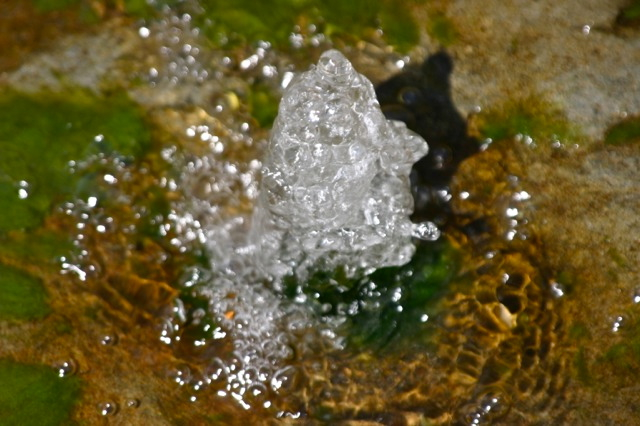
Pumped groundwater arriving at the surface.

Irrigation pipes are constantly moved from row to row to make sure the entire field gets sprinkled.
A failing water pump on a hot day like today can be devastating to the health and survival of sensitive crops such as strawberries and leafy greens. With the bulk of our spring plantings now in the ground, we are tending close to 40 different crops all needing water. Clemente, our irrigation manager is working long hours, up before dawn and working late into the night to beat the heat. He is constantly moving around from field to field, hauling and setting up sprinkler pipe, adjusting the water volume and pressure by turning valves on and off, and making sure there are no leaks in the system. Especially frustrating are the gophers that chew through drip-lines in the strawberry fields.
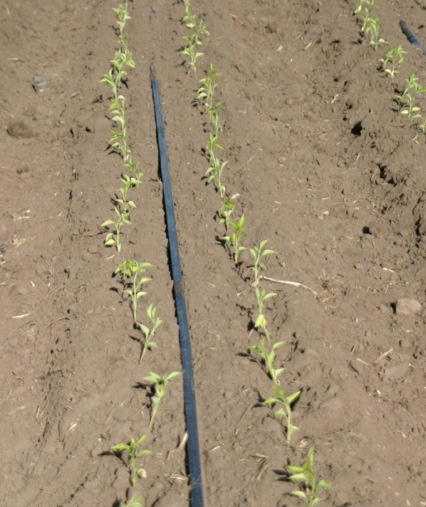
Crops like these peppers are set up with drip lines for precise irrigating.
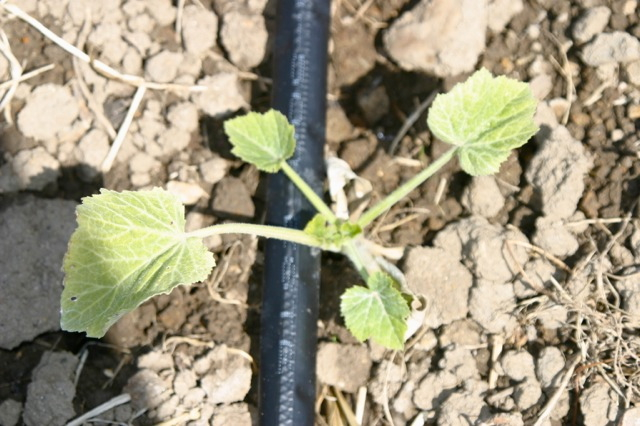
In this picture you can see where the water is perfectly placed (darker soil) to keep this squash plant hydrated.
A drought year is a stark reminder that we have grown foolishly accustomed to water that is available whenever we want it. We have converted an otherwise arid landscape into a highly-populated, abundant food-producing region. The climate is changing and we have no choice but to adapt and change with it. This year’s drought has left several hundred thousand acres of farmland fallow, and it’s anyone’s guess what the future of farming will look like. In the meantime, we can only hope that we have the ability to manage this precious resource equitably for all.
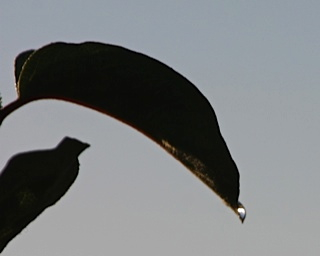
Early morning light picks out a precious drop of water.
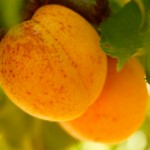 Perfect Ripeness
Perfect Ripeness
The most exquisite experience on the farm at the moment is to pick a perfectly ripe apricot right off the tree. The craving for these delicate, aromatic, and sweet fruit is almost irresistible, just trying to write about it makes me want to walk out and get one.
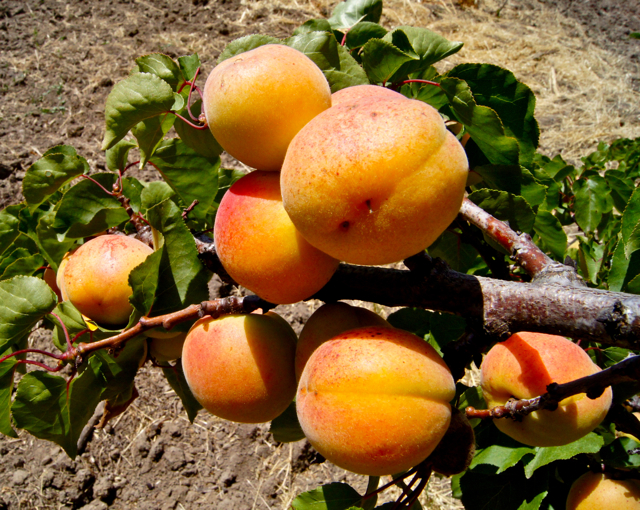
Perfect ripeness is hard to describe, it is the fruit that calls out, the fruit that gives a little when touched and releases itself into one’s hand. I will scan a tree and look for the telling colors of rich orange and red, any hint of green close to the stem means the apricot can still ripen a few more days. Once I set my eyes on that perfectly colored fruit I will gently touch, squeeze, and tug all at the same time. When fully ripe, it will just drop into the palm of my hand. You ask me what I love about farming – it is this nourishing experience of being rewarded by the land we steward.
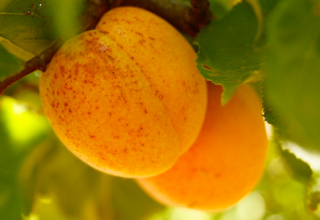
Come join us on the farm this Saturday to celebrate the Summer Solstice, and experience for yourself the reward of picking and enjoying a fruit directly from the plants and trees growing in our fields and orchards.
Saturday, June 21st – Solstice Celebration and Community U-picks
12:00 pm – 5:00pm: Community U-picking – strawberries, raspberries, and apricots
5:00 pm – Dark: Celebration and Potluck
Parking: Please follow the signs.
Parking for the Strawberry and Raspberry U-picks is at our 1275 Green Valley Rd Entrance (click for directions)
Parking for the Apricot U-picking, Celebration and Potluck is at our 172 Litchfield Lane Entrance (click for directions)
Overflow parking area at 1275 Green Valley Road. Parking at 1275 Green Valley Road means you will have to walk a ways – about a quarter mile, including a short distance up a fairly steep hill – to get to the main area of events. Save gas and carpool!!
Remember to bring jackets and sweaters as it gets cool later in the day, and a flashlight for navigating back to your car if you stay until after dark.
Potluck Details
- Everyone please bring something to share – an entree, a salad, a dessert – whatever you like! We never organize it more than that and always seem to have a nice variety.
- How much to bring? If in doubt, bring more, as we always seem to eat it all up! 😉 In all my years at Solstice Celebrations I have not seen folks going home with lots of left-overs!
- Please bring a serving utensil to go with your dish!
- Put your name on your dish and serving utensil with some masking tape or something, in case they get separated, and so we know who they belong to if they get inadvertently left behind.
- Please provide an ingredient list for your dish on a piece of paper or 3×5 card so folks with food allergies or special diets will know what they can and cannot eat.
- Where to put your pot-luck items when you arrive? We will have several tables for placing your pot-luck items on out near the fire circle. If you have something that needs to be refrigerated, you can pop it into our walk-in cooler to the right of the breezeway in our “upper barn” (Litchfield Ln Entrance). If it just needs to stay cool (not in the heat of your car), you can also put it on a table inside the breezeway/classroom area until pot-luck time. If you arrive closer to pot-luck time, simply bring it to the table area. We have extremely limited facilities for re-heating anything, so please don’t plan on that if you can help it.
- Beverages – There will be water and lemonade, but feel free to bring additional beverages for your own consumption or to share.
- We encourage you all to bring your own picnic plates, cups, bowls, silverware etc. in order to minimize unrecyclable garbage. We will have a washing station, where you can rinse them when you are through eating.
- And bring a blanket to picnic on, or your own chairs if you prefer.
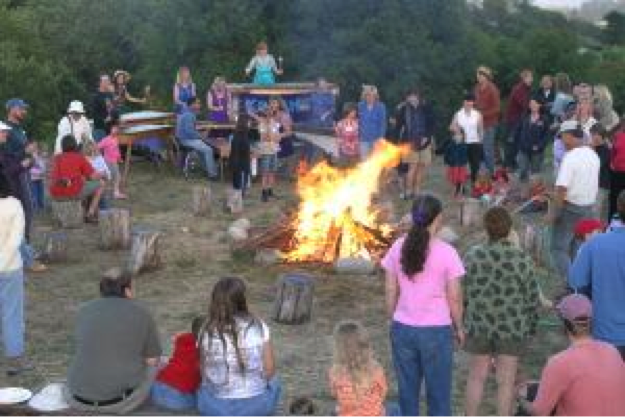
The season’s first rainmaker is predicted to approach the Central Coast this Friday and Saturday. Although no more than 1 inch of rain is expected to fall, it is enough to give us some drought relief. After almost six months of harvesting every single day, we are tired and dream of slowing down a bit during the hopefully rainier months ahead.

Fuji Apples ready for harvest.
With the exception of a few more rows of Fuji apples needing to be picked, our apple harvest is done for the season. Soon all the apples going into our shares (mostly our sweet Fuji’s) will be taken out of cold storage. After this next rain the strawberries and tomatoes will also officially be done, plowed back into the soil with a winter cover crop planted in the fields to rest and recharge the soil. The only fruit still being harvested for awhile longer are the pineapple guavas and, starting in December, our Meyer lemons should fully yellow to be enjoyed in our shares.

Frosty Cauliflower Field
Since crops are turning their energy inward to form seeds or store their energy in roots or trunks, winter is a good time to sow slower growing root crops that store in the ground over several months. The winter shares are a wonderful opportunity to enjoy both the nutrient dense earthy flavors of many of the root crops we grow (parsnips, celeriac, carrots, beets, and turnips), as well as the unique crisp textures and sweet flavors brassicas develop when temperatures drop into the thirties during the frostier winter nights ahead.
When the rain finally starts falling I will walk the farm to breathe a sigh of relief, surrendering to the inevitability of the more sinister decay of the farm’s crop lifecycle. The rotting windfall apples and tomatoes on the ground, I recognize, are the secret of fertility and the regenerative power of our earthly existence. I wish you all a spooky and safe Halloween!!
Together with my daughter, Elisa, I explored this season’s first maturing pepper field in search of the coveted “Chiles de Padron”. Although still a couple of weeks out before we have enough to put in the shares, we were able to fill a paper bag to enjoy for dinner.
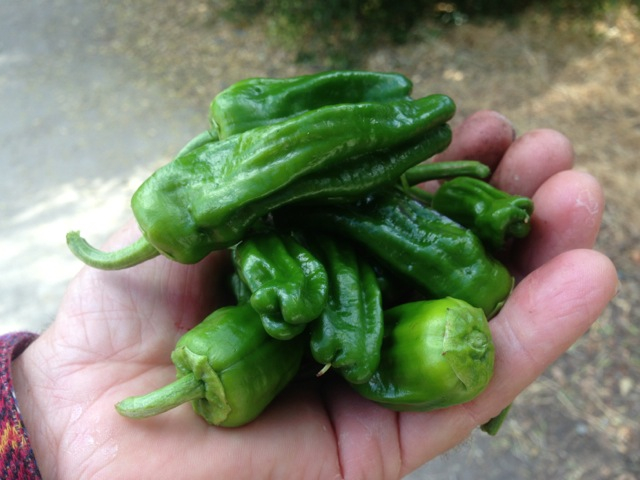
First Padron Peppers
The best way to prepare Padron Peppers is to simply throw them onto a hot cast-iron skillet until they are all blistered, sprinkle some good quality sea salt on them and they are ready to be enjoyed. Grab them by the stem; the little peppers you’ll finish off with a single bite, the larger ones no more than 2-3 bites. I promise, after tasting a few of them it’ll be hard to resist reaching for more. Elisa and I snacked down an entire bowl while preparing dinner.
Most of the time Padrons are mild, yet some exemplars, often the larger ones, can be quite hot. Typically, there is no way of determining whether a given pepper will be hot or mild, short of actually eating it. In our family it always turns into a fun game of daring each other to bite into one that looks spicy.
The first sweet Italian Long-Peppers (Corno di Toro) are being harvested this week, replacing broccoli in your shares. Due to the dry winter you will have noticed that many of our crops are maturing almost 2-3 weeks earlier this year. The second block of green beans will be ready for harvest next week, with the first tomatoes I anticipate showing up in your shares in a week or two (the first cherry tomatoes are going in this Thursday’s extra fruit option).
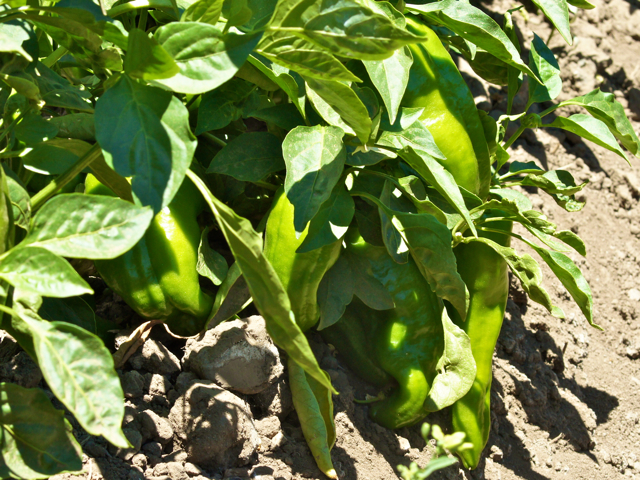
Corno di Torro Peppers
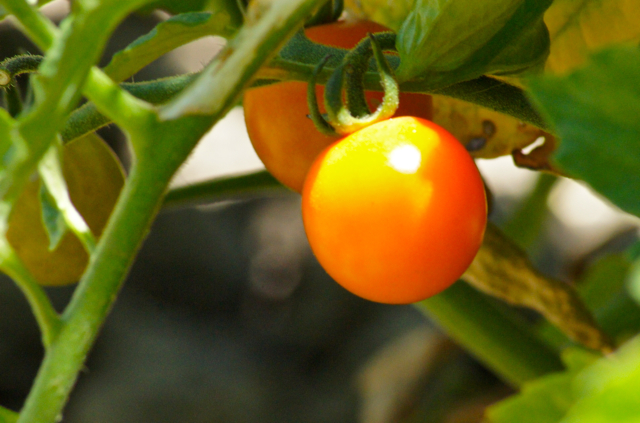
Sungold Cherry Tomatoes
I love the anticipation embedded in the seasonality of growing food. As a farmer it is exciting to anticipate the maturity of a crop, it is the highlight of the growing cycle, the time we can offer and share the results of our efforts. I like to honor new crops coming into season, harvested for the first time, by highlighting them in a family meal, a simple way to celebrate and be thankful.
That’s the advantage of local food. To experience the pleasure and taste of the seasonality of crops grown right here on our farm and harvested the same day you may prepare them into a nourishing dish. Mealtimes for our family – especially dinner – are important moments to slow down to be with each other. The quality of the meal we share contributes directly to the atmosphere of our time together as a family
At Live Earth Farm, we like you to experience a direct relationship to the land and people who grow the nourishing crops you eat. This intimacy and openness of the farm to its community has always been a guiding principle and a source of pleasure that continues to nourish our passion for farming.
